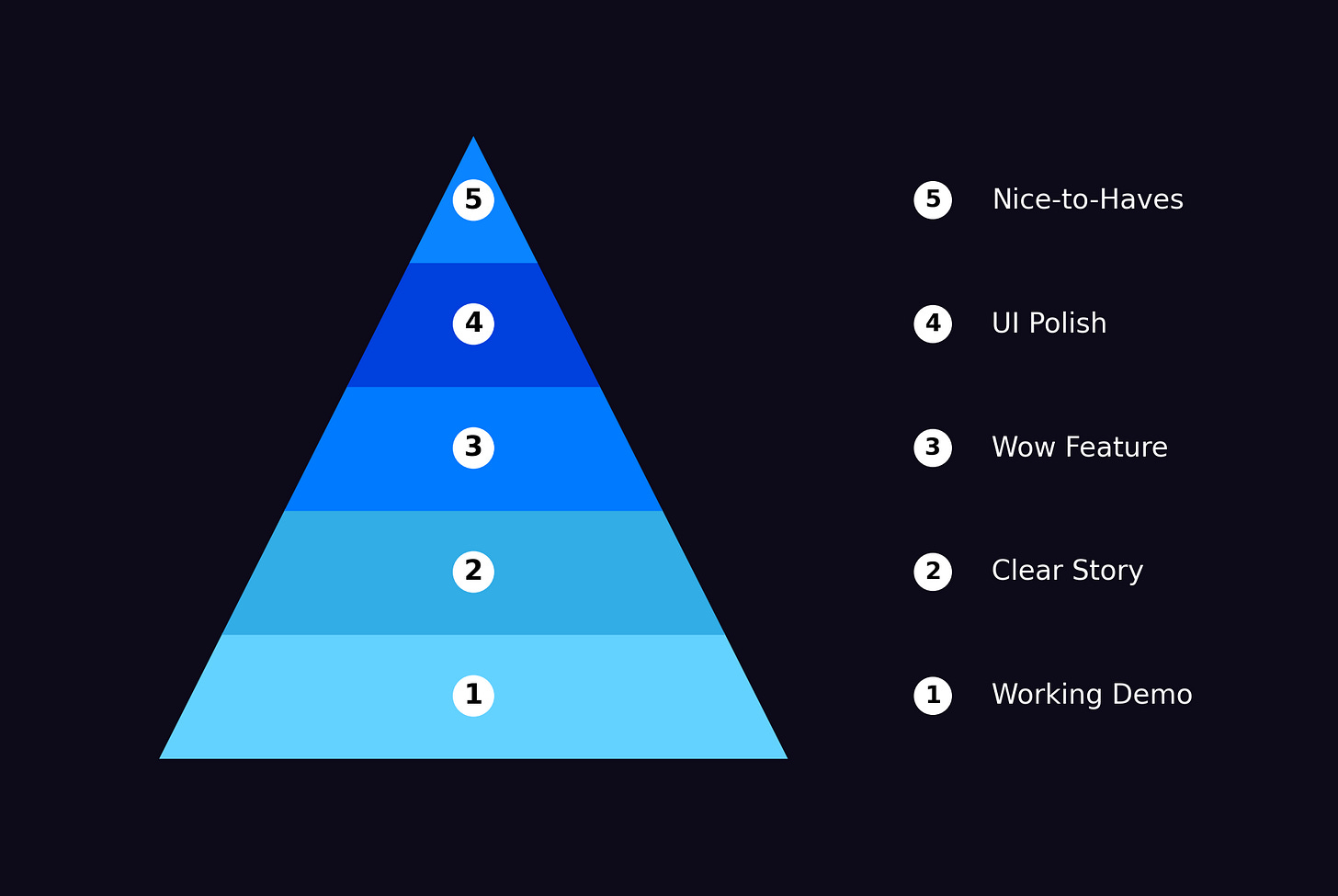The Pattern #9 - Hackathons 101
Why you shouldn't miss out on hackathons
I’ve attended five hackathons in 2025. They remain surprisingly underrated, and in this article I want to share my motivations, the lessons I’ve learned, and why you should experience a hackathon for yourself.
TL;DR
Hackathons aren't about writing perfect code - they're about moving fast, telling a great story, and working as a team. You get 24 hours to 2 weeks to build something that actually works and solves a real problem. Focus on creating a solid demo, throwing in one cool feature that makes people go "wow," then pitch it like you mean it.
The best part isn't winning prizes - it's learning new skills on the fly, meeting amazing people, and getting that incredible rush from building something from scratch in record time.
First Hackathon
My first hackathon wasn’t even on my radar.
I was looking up a startup’s pitch deck for work, when I stumbled across an old video of them presenting at Startup X. Checking out the website I noticed they had a healthcare-themed hackathon running.
I thought: Why not?
I ended up building a platform for eczema sufferers to track symptoms via a food diary, then used AI to flag potential dietary triggers. It was rough, but it worked well enough to demo.
That one event turned into five hackathons over time, because once you’ve had that rush of building and presenting something in such a short burst, you want to do it again and again.
But lets take a step back…
What is a hackathon?
A hackathon is a time-boxed build, anywhere from 24 hours to two weeks. You (solo or in a team) get a theme or problem statement and create a proof of concept to present/submit at the end.
Typically, there are different tracks that you can pursue within each theme where in there several problem statements for each track. As an example, I recently did a Hack for Gaza hackathon of which the overall theme was building a solution to help our brothers and sisters in Gaza. These were the following 3 tracks:
Healthcare
Political activism
Humanitarian aid/NGO support
The goal: demo something that convinces people your idea is a potential solution to the problem statements, not ship production ready code.
Why should you join a hackathon?
The upside of a hackathon is uncapped. You potentially are building something that could be the foundation of a startup. Hackathons give you that short focused time to work on a real problem that matters with domain experts judging. That is not something that is necessarily available outside of hackathons readily.
But, let’s be brutally honest. Most ideas are not one that are going to break you out of your 9-5 job, so what might motivate you then?
Well, the following might:
Cash prizes. Enough said.
You’re forced to learn new tools on the fly. like I did with learning about AI agents orchestration and that pressure cements skills in a way tutorials can’t
You get to build fast without overthinking, often around real world themes like healthcare or humanitarian aid, which makes the work feel meaningful.
It’s a way to organically grow your network. You get to meet developers, designers, PMs, and domain experts you might never cross paths with otherwise, and sometimes those relationships turn into future collaborations.
You walk away with a portfolio ready project that can be shown off on LinkedIn or in interviews. Coder Co puts it bluntly: a CV alone isn’t enough anymore. Employers want to see proof of execution. A hackathon project is tangible evidence you can ship under pressure.
Do I need to be experienced?
A common misconception is that hackathons are only for developers and experienced ones at that. In reality, I’ve worked with:
Product managers — e.g. Google PMs who shaped the vision and pitch.
Designers — UI/UX engineers who made the product feel real.
Domain experts — doctors, lawyers, educators who kept us solving the right problem.
And now, with vibe coding and tools like Replit, Lovable, and Codewords, you can go from an idea to a working prototype without needing a computer science degree.
The bar to entry has never been lower. The advantage goes to those who can frame a clear problem and move fast, not just those who can write the cleanest code.
Of course the same is true for developers with tools like Cursor and Claude Code.
How does a hackathon go?
While formats vary, most hackathon teams follow a similar rhythm. Here’s how a short single day hackathon typically plays out:
9:00 AM – Check-in & Networking
Get your badge (or log into Slack/Discord if it’s online), grab some food, and start talking. This is where I would scout potential teammates and get a feel for the event.10:30 AM – Kickoff
Organisers outline the theme, tracks, and problem statements. I’d listen closely as the judging criteria are hidden between the lines of this intro.11:00 AM – Team Formation & Ideation
Lock in your team. Brainstorm freely, but cut ruthlessly — a small, focused idea will beat an ambitious mess.12:00 PM – Domain Expert Check-in
Validate early. At the Hack for Gaza hackathon, doctors who had worked on the ground gave instant feedback on healthcare ideas — I found this to be the fastest way to kill bad assumptions.12:30 PM – Core Build
Define your must haves and skip the “nice to haves.” Winning teams get a demo running fast, then layer extras only if there’s time.4:00 PM – Halfway Checkpoint
Have a bare bones internal demo by now. It doesn’t need to be pretty, but it should already prove your core idea works.6:00 PM – Enhancement Phase
Now add one memorable “wow” feature and tighten the UI. This is what sticks in judges’ minds after they’ve seen 20 demos.8:00 PM – Final Push & Submission
Merge your code, fix last minute bugs, and polish your pitch deck. Even the best builds lose if the story isn’t clear.
By 9 PM, you’ve gone from strangers with a theme to a proof of concept worth showing off and, if you’ve done it right, a serious shot at the win.
Hackathon priorities pyramid
Heres how I’d prioritise during a hackathon.
At the very least you should aim to have a working demo, as previously mentioned.
My winning pitch template
So look one of the most daunting parts about is on top of building the demo you may then need to pitch that idea.
This is how I structure a 2-minute live pitch with a pitch deck. Use Loom.com to record your pitch if you need to submit a recorded demo.
Remember: The deck isn’t there to mirror your words, it’s there to make them stick.
⏱ 0:00 – 0:20 → Hook & Problem
Open with a short, human story or relatable scenario.
Example: “Last week, Sarah missed her hospital appointment, not because she was sick, but because the hospital couldn’t coordinate her ride.”
End with a sentence that makes the pain obvious: “This happens to thousands every year, costing hospitals millions.”
On the slide, this is just a single powerful image or one striking stat, nothing else. You want the audience to feel the problem before you explain it.⏱ 0:20 – 0:40 → One-Line Solution
Introduce your product name and deliver a simple, clear value proposition: “CareConnect matches patients with real-time transport options in seconds.”
Your slide here is your logo, tagline, and maybe one sentence — clean and uncluttered.⏱ 0:40 – 1:40 → Demo in One Seamless Story
Pick a single user scenario. Keep it realistic and relatable.Example: “Sarah books hospital transport on her phone.”
Break it into three or four micro-steps:Step 1: Sarah opens the app.
Step 2: AI matches her with a driver instantly.
Step 3: Booking confirmed, driver en route.
Step 4 (Optional): A quick behind the scenes visual if it’s technically impressive.
Narrate while you click through — your slides here are just screenshots, short clips, or clean visuals of each step. Avoid “imagine this” — preload data or use short videos so nothing breaks. The goal is to show the value, not describe it.
End this section with the “aha moment”: “Now Sarah gets to her appointment on time and the hospital sees fewer missed visits.”⏱ 1:40 – 1:55 → Results & Impact
Quantify the benefits. “This reduces missed appointments by 40%, saving hospitals £500k a year.”
On the slide, one chart or big-number metric is enough. Tie it back to your opening story so it feels like a complete loop.⏱ 1:55 – 2:00 → Memorable Close
One emotional or clever tagline. “CareConnect - because no one should miss care for lack of a ride.”
The final slide is just that tagline with one image that reinforces it. End on something that will stick in their heads when you walk off stage.
Where to find hackathons?
Hopefully the above has inspired you to venture off into your first hackathon or at least think about it. So I couldn’t leave you without links to a few places where you can find them:
And of course keep on eye out on social media platforms like LinkedIn and X
Plugs
A collection of interesting links I’ve found from trawling the internet
At-Tawbah (The Repentance) - Nasser al Qatami
tldraw - Very good white boarding tool. Think of it as excalidraw but better.
SnitchBench - bench mark for which language models will snitch (spoiler: its all of them)
GPT-5 - A good read on a blog giving a more realistic insight on GPT5s performance improvement.



